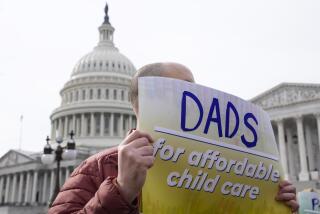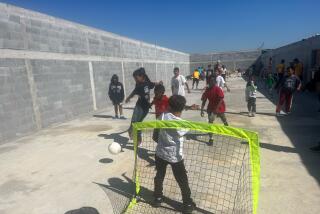Primary Education : IT TAKES A VILLAGE: And Other Lessons Children Teach Us, By Hillary Rodham Clinton <i> (Simon & Schuster: $20; 318 pp.)</i>
Hillary Rodham Clinton did not become a children’s advocate after she became first lady. Her work, particularly with the Children’s Defense Fund, has been nonstop for 20 years. The book’s title comes from an African proverb--”It takes a village to raise a child”--and its primary theme is that we are all interconnected. “No family is immune to the influences of the larger society. No matter what my husband and I do to protect and prepare Chelsea, her future will be affected by how other children are being raised.”
It was not so long ago that President Reagan had to be convinced that there was no such thing as a limited nuclear war. What Hillary Clinton is attempting to accomplish with this book is on the same scale. She argues forcefully what ought to be self-evident: That we cannot allow the wholesale abandonment of children in unfortunate circumstances.
“I write these words looking out through the windows in the White House at the city of Washington in all its beauty and squalor, promise and despair. In the shadow of great power, so many feel powerless.” At the height of power, Clinton has never stopped seeing these children. She is clearly on a mission, and she champions them from every perspective.
The book is written for a variety of readers--politicians, mothers, social workers, teachers and just about anyone who comes in contact with children. In practical terms, Clinton offers advice on what to look for in a child-care situation, the types of foods that help children grow and techniques for preparing your child to cope with adversity.
On the policy level, she advocates programs for pregnant women such as one she sponsored in Arkansas, with the help of local merchants. “After every month’s pre- or postnatal exam, the attending health care provider validates a coupon, which can be redeemed for free or reduced-priced goods such as milk or diapers.” She cites companies such as Haggar Apparel in Dallas and Levi Strauss in San Francisco, which “provide incentives to encourage their employees to seek prenatal care.”
In political terms, she argues forcefully for guaranteed medical care for children. “Today there are more than 10 million children, most with working parents, who do not have health insurance: That number has been rising by about a half-million a year. The rate will accelerate even more if Congress’ proposed cutbacks in Medicaid, which provides government insurance for poor children, are enacted.” She wants all children to have health coverage and all hospitals to have to treat them.
When you step back from the book, the most shocking thing is that the first lady of the United States has to argue for this at all. She writes: “Hospitals do not turn away older Americans (at least not as of this writing) because their coverage is guaranteed by Medicare. Why can’t we guarantee care for children?” She recounts nightmare stories of families unable to find coverage for disabled children and of children dying when they were not promptly admitted to hospitals in emergency situations.
Clinton tells of her Methodist upbringing and of the infusion of social justice with spiritual values: “My church took seriously its responsibility to build a connection between religious faith and the greater good of a society full of all kinds of people.” She has a Kennedy-era New Frontier mentality, which is quintessentially American: Anything can be done if you’ve got enough energy and determination. She writes of “the struggle to live up to the spiritual values we profess,” warning that “groups of people, even nations, can suffer from an absence or misuse of spirituality” and that “preaching is a distant second to practicing when it comes to instilling values” such as compassion, peace and hope.
Clinton’s anger at the treatment of the working-class or disadvantaged child is palpable in chapters such as “The Bell Curve Is a Curve Ball,” a reference to the theory that intelligence is fixed at birth, part of a genetic makeup that cannot be changed. “This view is politically convenient,” she writes. “If nothing can alter intellectual potential, nothing need be offered to those who begin life with fewer resources or in least favorable environments.” She cites the recent work of psychologist Daniel Goleman, who advocates the need for understanding and developing emotional intelligence as a balance to the purely rational. Emotional intelligence, as Goleman describes it, is the seat of empathy, and it is only through empathy that we can come to make decisions that benefit not only ourselves but our society.
“It Takes a Village” demonstrates intellectual vitality and openness to new ideas. This is a woman who is helping to shape the national dialogue, whether she is arguing for flexibility in traditional gender roles (what might be thought of as gender independence) or for some soul-searching on the boards of profitable American companies that vote to lay off lifelong workers in the name of efficiency or impose part-time work to avoid paying employee benefits.
The book closes with a gratitude list for the programs that have added to the quality of American life, such as Title IX (which, in effect, opened collegiate athletics to women), the Clean Air Act, Social Security and Medicare. While some might see these programs as big-government excess, Clinton sees them as the last line of defense for the average person.
She writes, “We must ask ourselves: Who benefits from the elimination of federal regulations that protect us from outbreaks of contaminated drinking water or cases of tainted meat? Who benefits from a decrease in federal pollution standards, or from the kind of massive deregulation that could allow companies to dump toxins into our nations’ oceans, rivers and lakes? Certainly not our families or our children.”
Throughout this book, there is the sound of tempered frustration and unshakable determination, a missionary’s zeal and a mother’s vulnerability. “It Takes a Village” is an honest book. It is not a book for cynics, but it will be welcomed by those who want to understand just who Hillary Rodham Clinton is and what we can do to help the children in our village.
More to Read
Sign up for our Book Club newsletter
Get the latest news, events and more from the Los Angeles Times Book Club, and help us get L.A. reading and talking.
You may occasionally receive promotional content from the Los Angeles Times.







